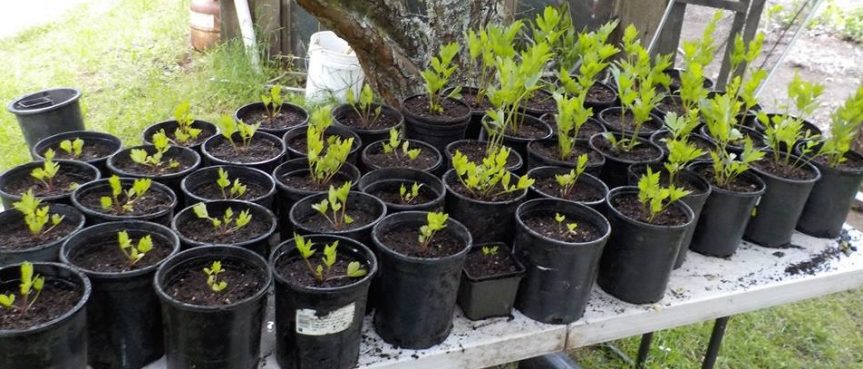Growing 歐當歸 [Ōudāngguī] Levisticum officinale, lovage
‘Love Herb For The People’
In China, lovage is known as 歐當歸 [Ōudāngguī], which literally translates as ‘European Danggui’ , because the root has been used as substitute for Chinese angelica root – 當歸 [dāngguī]. The leaves of the two plants look similar as well. The most important medicinal actions of the root as described in 中药大辞典 [Zhōngyào dà cídiǎn] are:
- supplementing and harmonizing the blood
- regulating menstruation (used for menstrual block and menstrual pain)
- moistening dryness and lubricating the intestines
It is also used for dizzy head and headache if these are related to blood vacuity. Welling- and flat-abscesses and sores are also mentioned as indications.
Since the properties of Chinese angelica root are extensively described in English literature elsewhere, this is just a summary.
Note that compared to 當歸 [dāngguī] – Chinese angelica root, 歐當歸 [Ōudāngguī] is relatively weak in medicinal action.
(For the complete entry in Chinese form 中药大辞典, see end of this post)
A monograph in English on lovage can be found in ‘The Energetics of Western Herbs – A Materia Medica Integrating Western and Oriental Herbal Medicine Traditions’ by Peter Holmes. In the second edition, the index page number is 175 but I found it on page 185.
In Holland this widely grown vegetable garden plant is called maggiplant (Maggikraut in Germany and Maggichrut in Switzerland). I knew ‘maggi’ before I knew the plant because we had it on the dinner table (in a silver container that was specially designed for those bottles, similar to the one in the picture below) whenever we ate soup. As a liquid seasoning mix it came in a dark brown bottle with Maggi as brandname. My mother also always kept Maggi cubes in the kitchen to add to home-made soups.
The original German name (before its association with the seasoning products with the brandname Maggi) is Liebstöckel, and in Dutch the other common name is lavas.
Italian: levistico or sedano di monte; French: livèche; Romanian: leuştean; Hungarian: lestyán; Russian: любисток lyubeestok.
A friend from Romania gave some additional information:
<<“Vegeta” or “Maggi” were widely used in my native Romania occasionally when cooking for extra flavouring. However, lovage extract as such, cannot be defined by these products. My parents and grandmothers were using lovage a lot but mostly in some sort of sour soup called “ciorba” that was made with a naturally fermented sour liquid called “bors”. This naturally fermented liquid was being made by adding also lovage stems and leaves, and sour cherry tree leaves, along with horseradish root. Thus, the resulting sour liquid contained all the benefits from these herbs.>>
In Bulgaria, it is known as девесил deveseel. The Czech name is libeček, and the Polish name is lubczyk, both meaning ‘love herb’. The name in Swedish is libbsticka; Norwegians say løpstikke.
The Croatian name for this plant is ljupčac or vegeta (named after a well-known Croatian meal seasoning similar to Maggi).
The Finnish name is liperi or lipstikka, the former meaning ‘preacher’s collar’, because in old ages the plant was cultivated in monasteries or in rectories, while the latter is from Swedish.
I have noticed that lovage is not widely known among gardeners in the U.S. of A., and since I also discovered its use in Chinese medicine, I decided to grow it in an amount that enables me to give it as a present to garden- and herbal medicine friends in America. I sold some at farmers’ markets as well.
In the pictures you see the plants during the second potting in late spring. The seeds were planted in january. It is a perennial plant and it is wise to give it some space as it can grow quite large. For many gardeners it is a must to have one or two in the vegetable garden.
After one or two seasons you can dig up the plant, split the roots and replant.
For medicinal use of the root, leave it in the ground for a couple of years.
欧当归 {complete entry from <<中药大辞典>>}
【药材名称】欧当归
【拼音】ōu Dānɡ Guī
【英文名】Root of Garden Lovage
【出处】始载于《中药志》。
【来源】药材基源:为伞形科杆物欧当归的根。
拉丁植物动物矿物名:Levisticum officinalis Koch[Ligusticumleuisticum L.]
采收和储藏:春、秋季采挖其根,去除茎叶,洗净,晒干或烘干。
【原形态】多年生草本,高12.5m。全株有香气;根肥大,有支根。茎光滑无毛,有纵沟纹,紫红色,中空。基叶和茎下中叶二至三国顺羽状分裂,有长柄,叶柄基部膨大成长圆形、带紫红色的叶鞘;茎上部叶通常仅一回羽状分裂;茎生叶叶柄较短,最上部的叶多简化成先端3裂的小叶片;叶缘下部全缘,先端锐尖,基部楔形。复伞形花序径约12cm,伞辐12-20;总苞片7-11,小总苞片8-12,均为宽披针形至线状披针形,先端反曲,边缘白色,膜质;小伞形序近圆球形;萼齿不明显;花黄绿以,花瓣基部有短爪。分生果椭圆形,背部稍扁压,长5-7cm,宽3-4cm,侧棱和背棱呈阔翅状,每棱槽内有油管1,合生面油管2。花期6-8月,果期8-9月。
【生境分部】生态环境:我国华北及辽宁、陕西、新疆、山东、灌输、河南等地有栽培。
资源分布:原产亚洲本部。欧洲及北美各国亦多有栽培。
【化学成分】含多种挥发油成分,主要为藁本内酯(ligusti-lide)[1-4],β-水芹烯(β-phellandrene),香茅醛(citronellal)[1]。还含亚丁基苯酞(butylidene phthalide)[4],正丁基苯酞(butylph-thalide),伞形花内酯(umbelliferone),补骨脂素(psoralen),香柑内酯(bergapten)[5],镰叶芹二醇(falcarindiol)当归二内酯(ange-olide)[6],洋川芎内酯(senkyunolide)[7],芸香甙(rutin),山柰酚-3-O-芸香甙(kaempferol-3-O-rutoside),异槲皮素(isoqrercetin),紫去英甙(adtragalin)[8],阿魏酸(ferulic acid),苯甲酸(benzonic acid),丁二酸(succinic acid),腺嘌呤(adenine),蔗糖(sucrose)。薄层色谱表明尚有葡萄糖(glucose)、果糖(fructose),烟酸(nico-tinicacid)和氨基酸等[9]。此外,本品尚含5种新的藁本内酯二聚体( ligustilidedimer)[6]。
【药理作用】根的水浸膏及挥发油具抑制子宫节律性收缩,对抗乙酰胆硷对子宫和肠道平滑肌的痉挛作用。无水乙醇提取物有雌激素样作用。
【性味】味辛;微甘;性微温
【功能主治】活血调经;利尿。主经闭;痛经;头晕;头痛;肢麻;水肿
【用法用量】内服:煎汤,6-15g;或入丸、散。
【各家论述】《新华本草纲要》:治疗闭经、月经涩少和痛经均有一定疗效。同时对头晕、头疼、四肢麻木、失眠、大便干燥等症状也有显着疗效。
【摘录】《中华本草》




